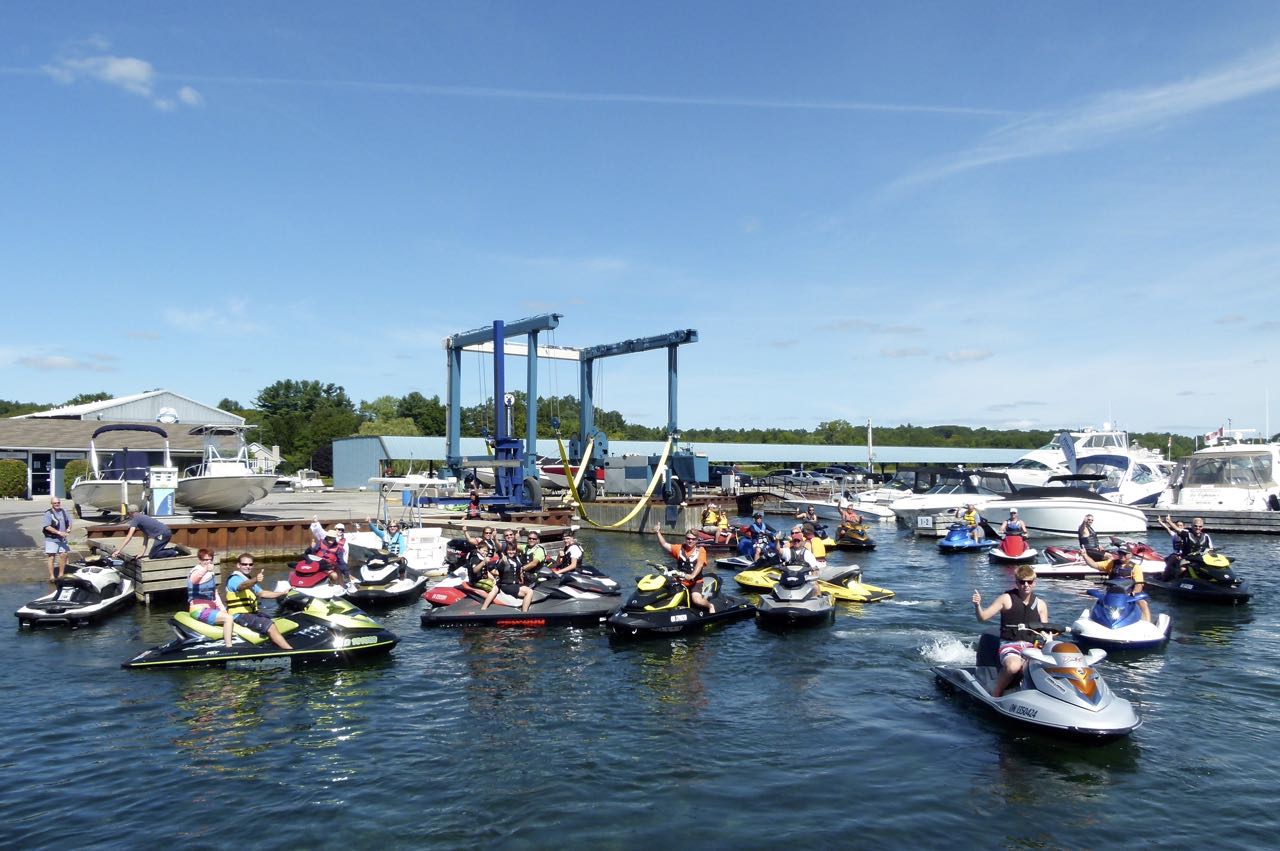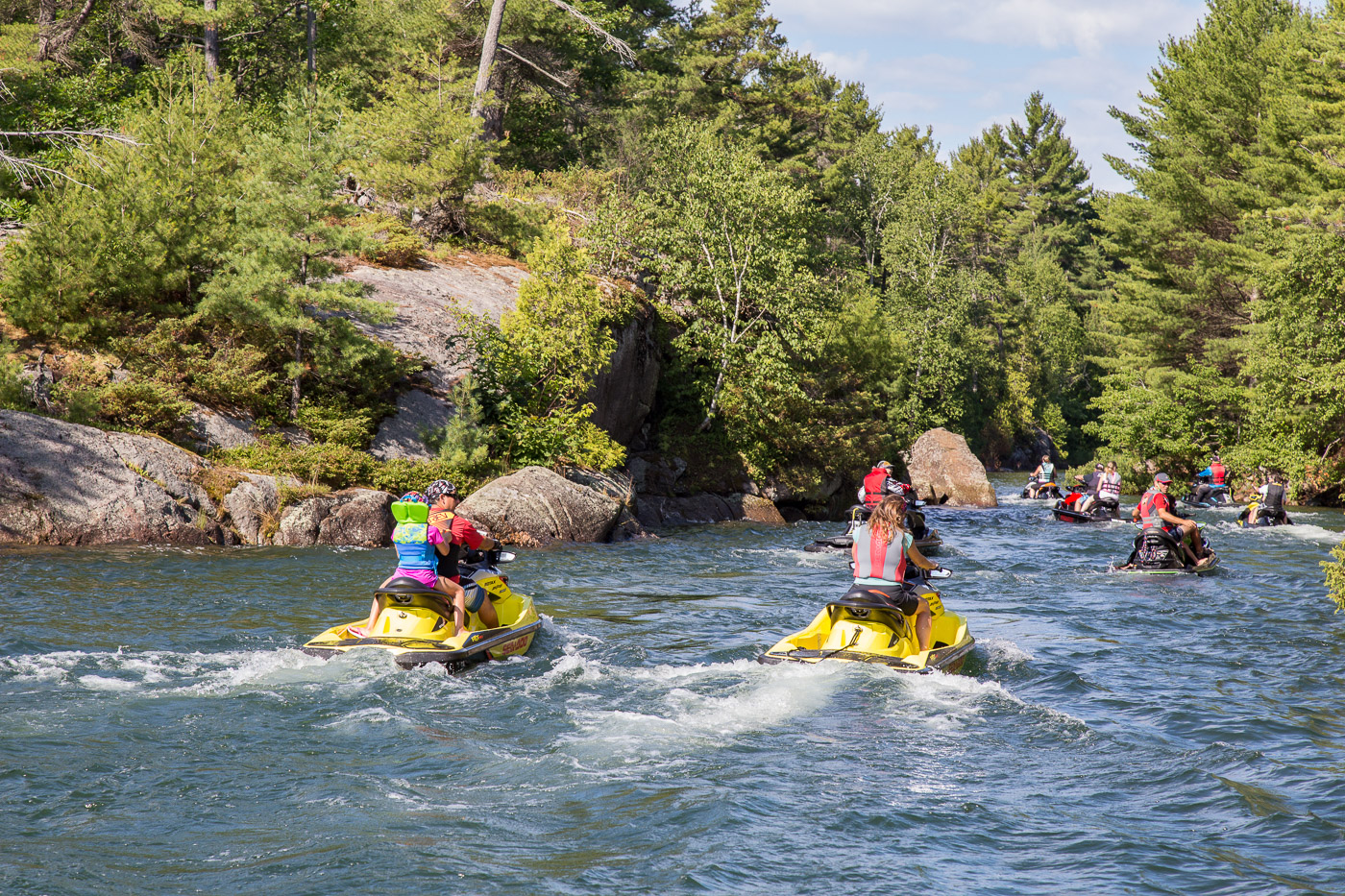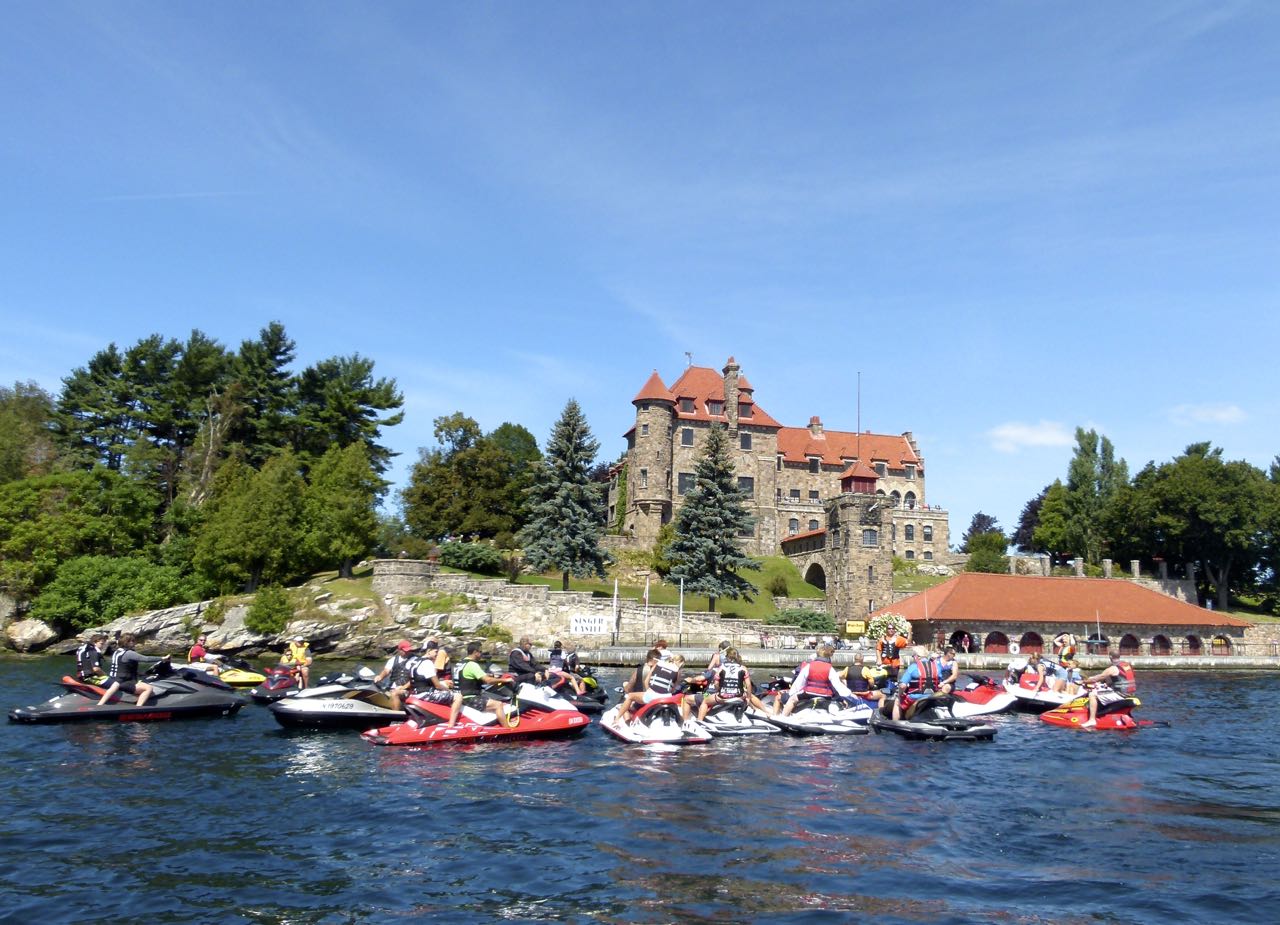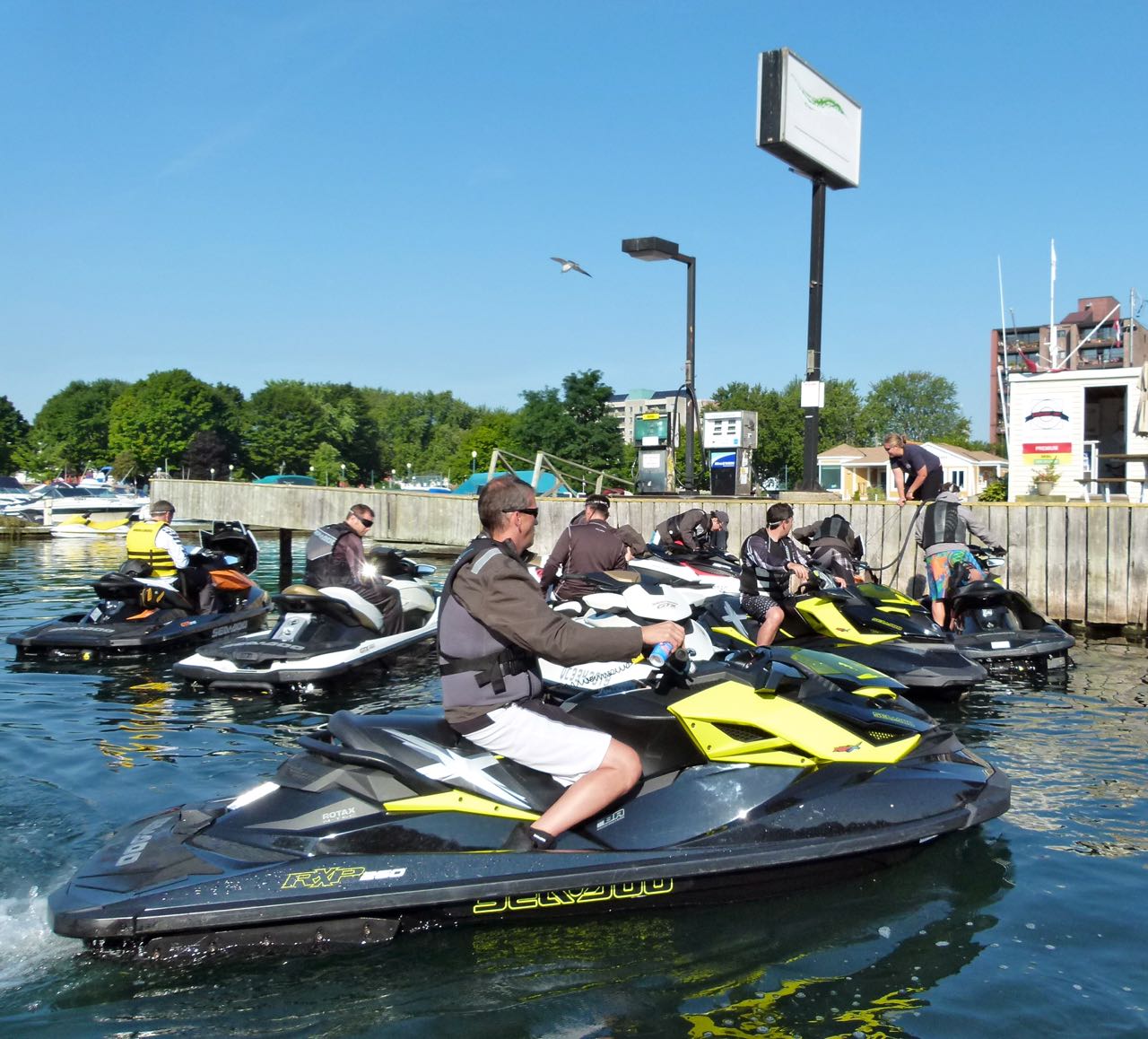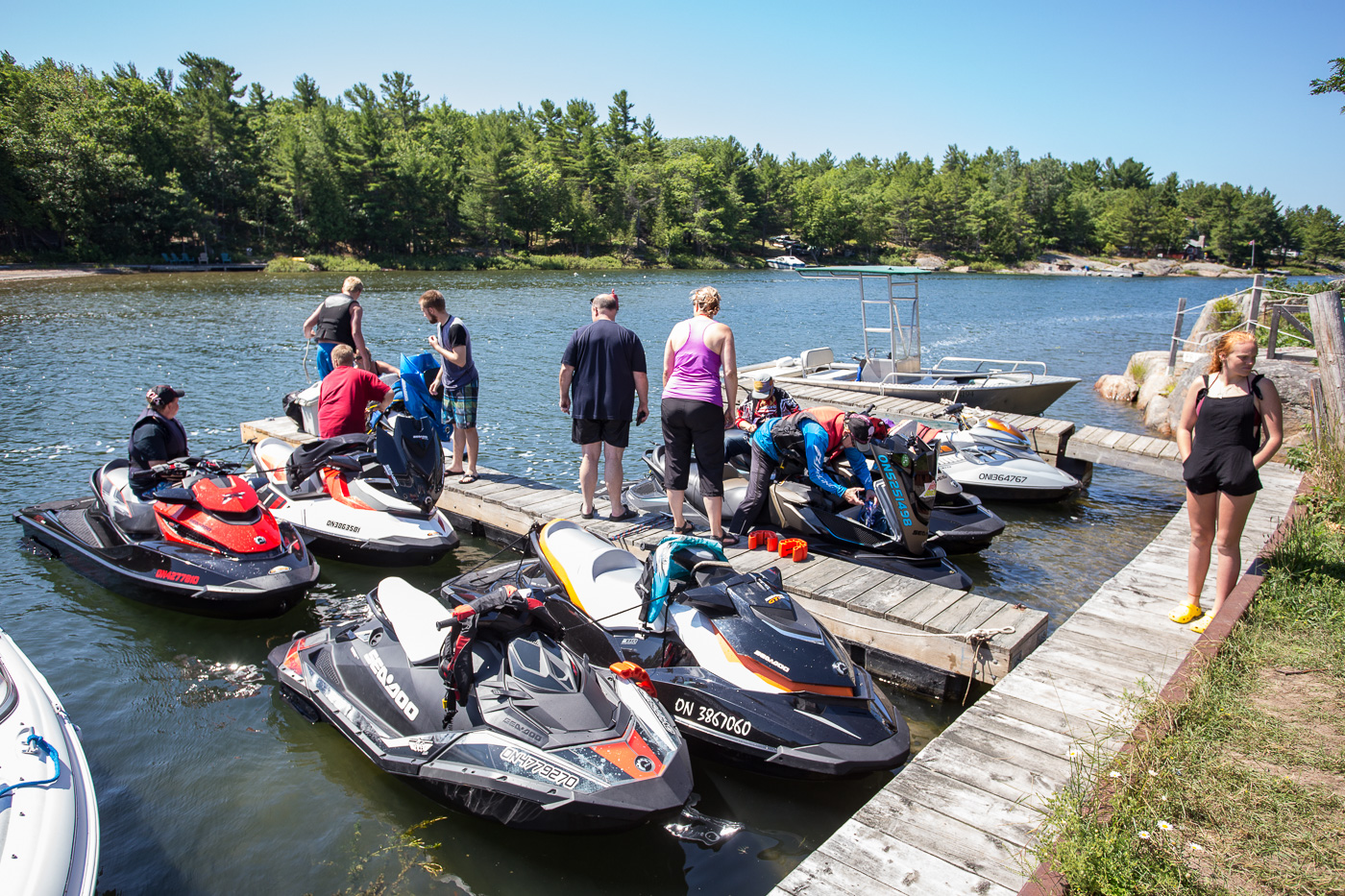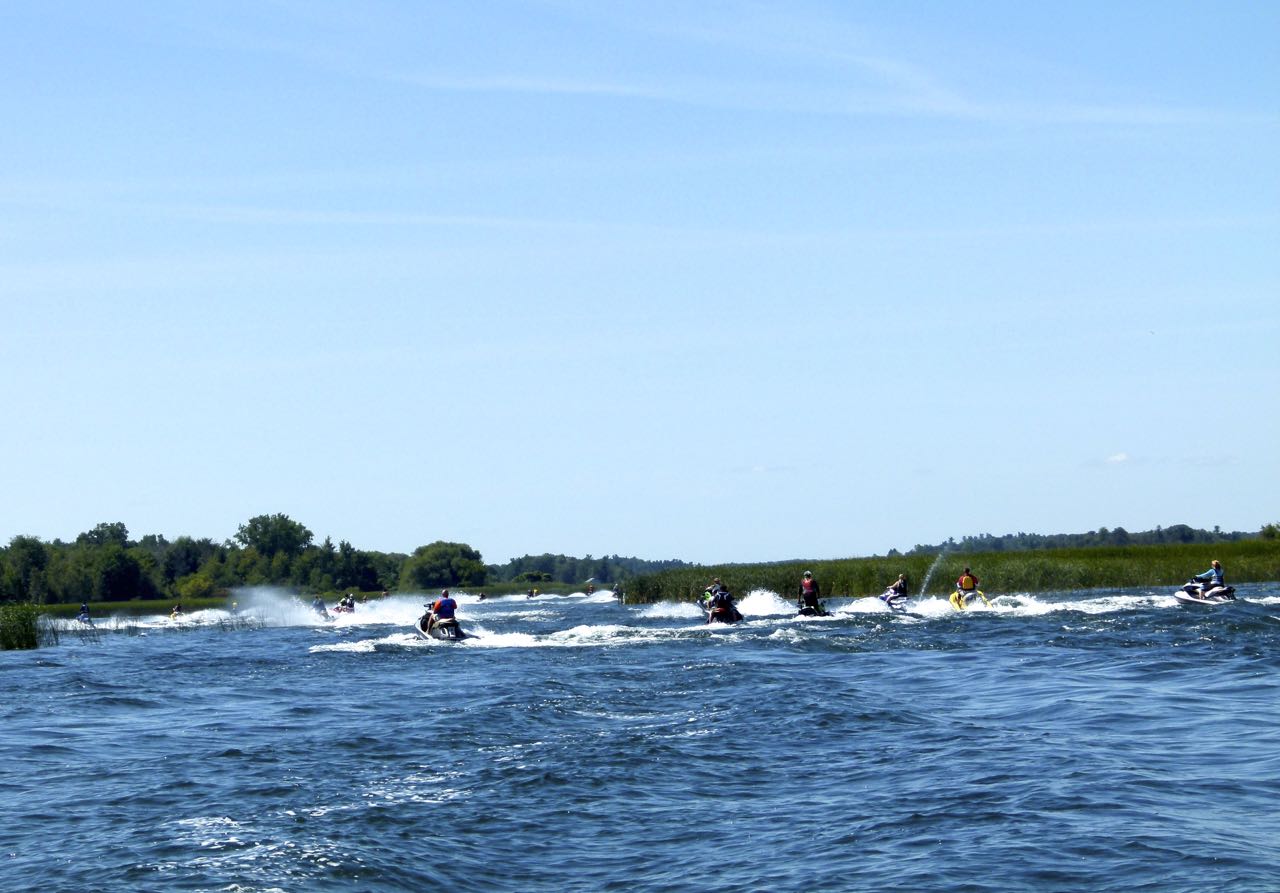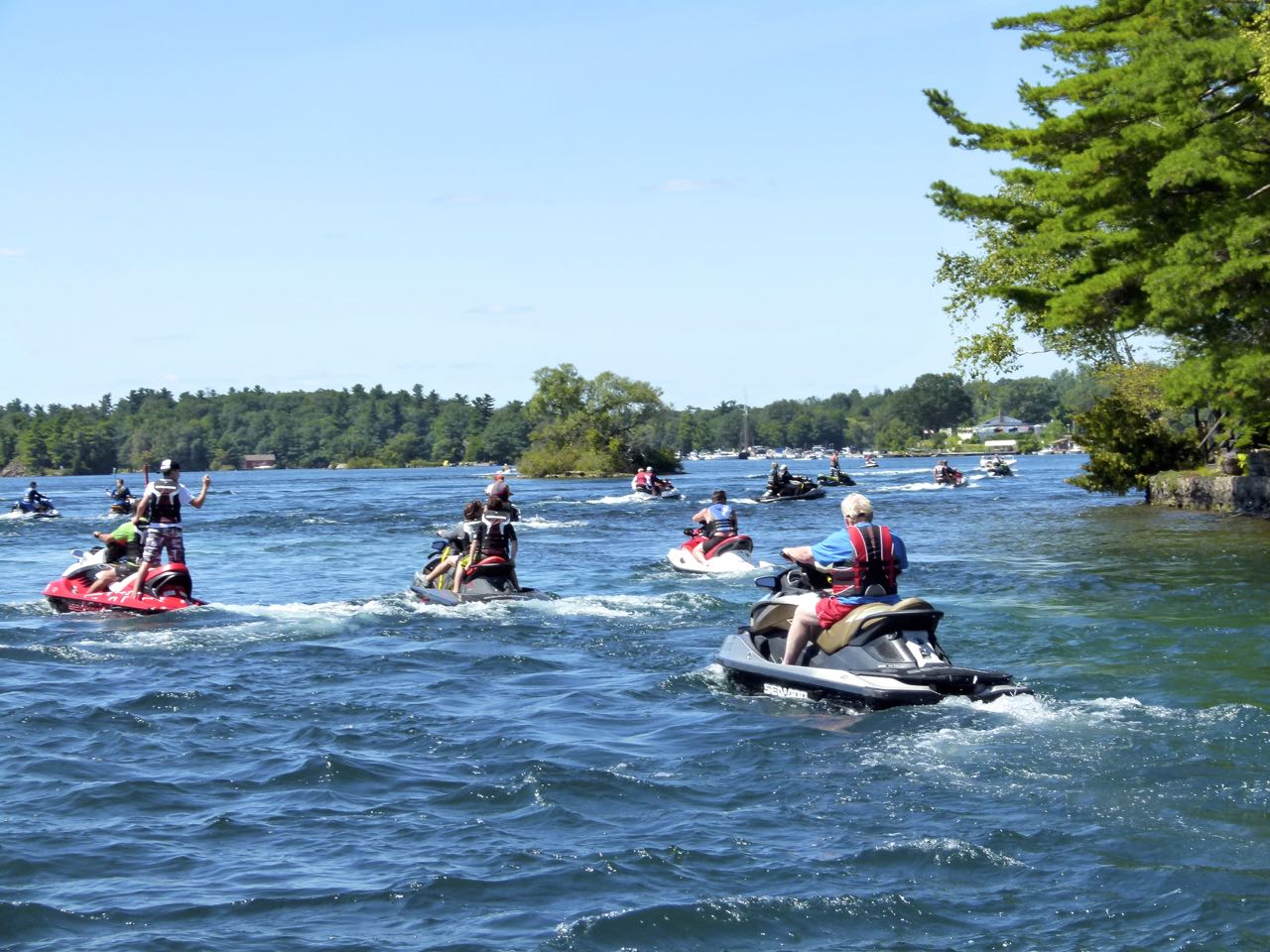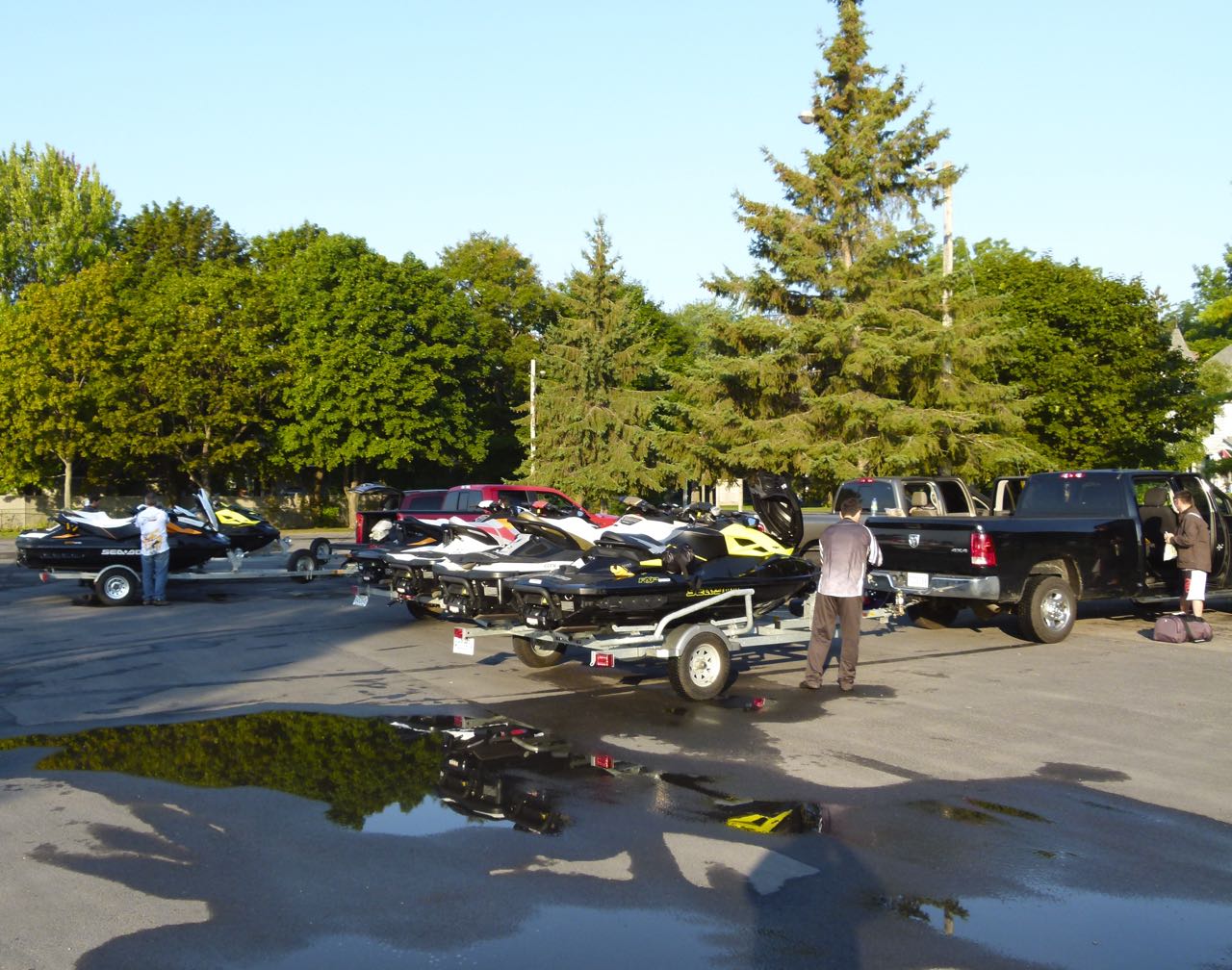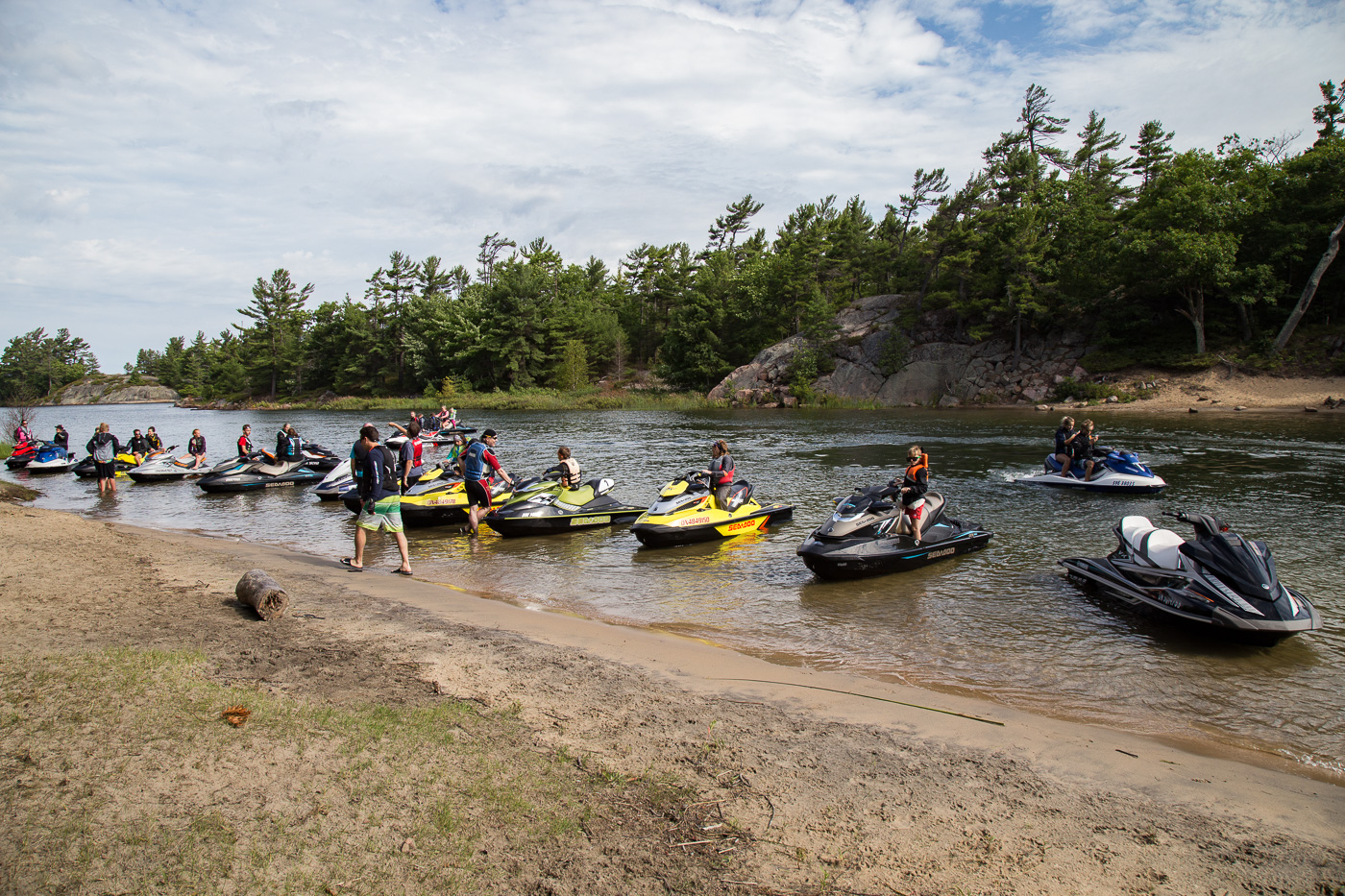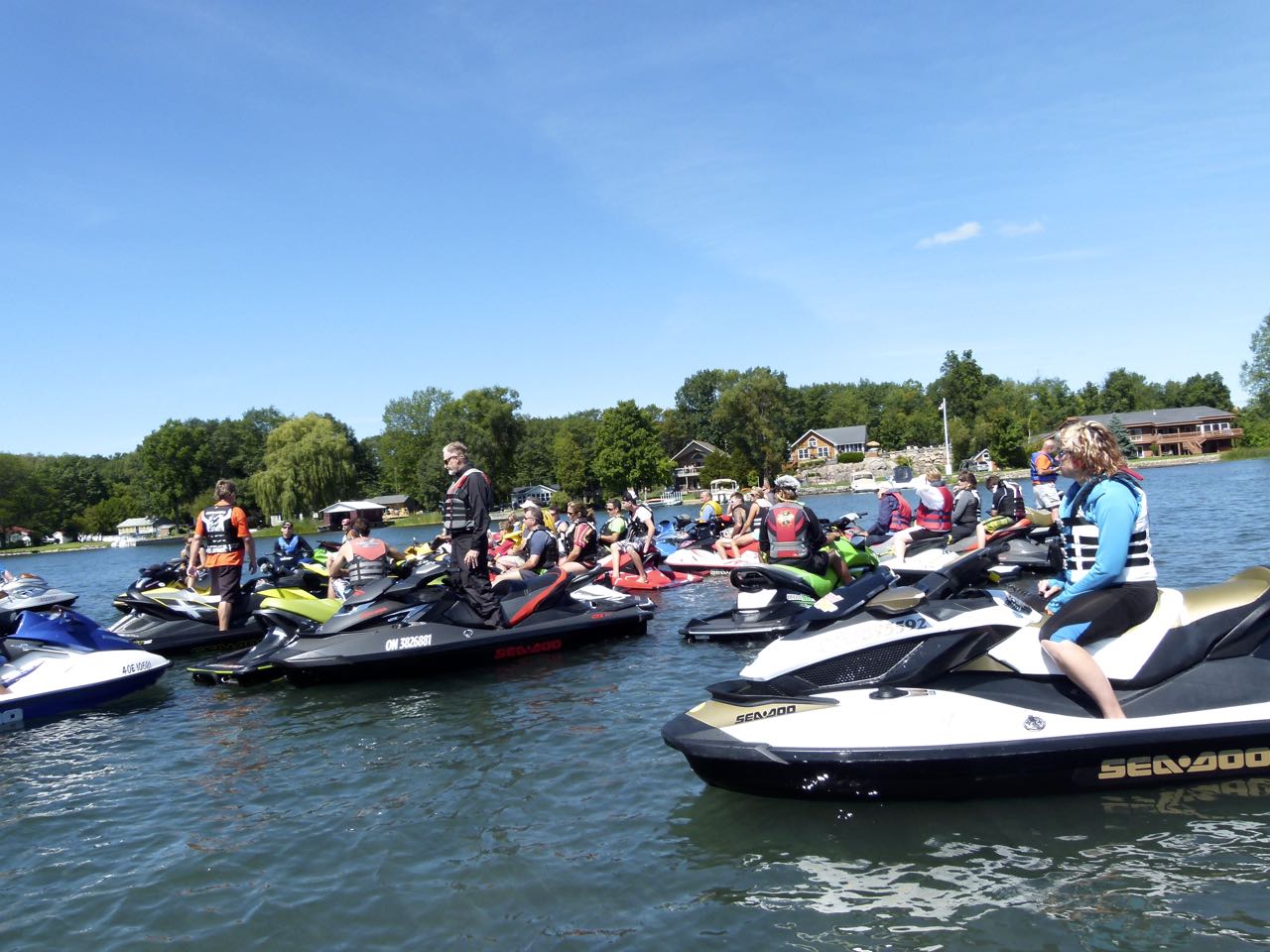PWC Advice For Large Sea Doo Rides…
Related: Safe Riding Tips
Why are large PWC group riding caution tips timely? Personal watercraft sales are up in recent years. So, many more owners are going on jet ski day rides and multi-day Sea Doo tours. Typically, I see small groups of up to a half dozen jet skis out for a ride. But increasingly, I’ve also noticed larger groups of 20 Sea Doo’s or more together for PWC adventures.
Riding with others is great for camaraderie, fun, peace of mind and discovering unfamiliar waterways. But I get the same benefits and more from jet ski riding in a smaller group and prefer to do so. Here’s why…
Smaller Groups Advantages
Rider Confidence
With a smaller PWC group, it’s easier to accommodate jet ski riders of similar experience levels and to match everyone’s expectations to the proposed ride. And for all riders to be confident in each other. Besides, you know up front who’s coming, with none of the surprises that can result from an open social media invitation, where no one knows who or how many will show up.
Rider Capability
For me, it’s important to know beforehand what riders in your jet ski group are capable of, and what kind of Sea Doo ride they like. This prior insight helps avoid possible issues and tensions once the ride is underway. Also, it can help pre-determine both the distance and pace your PWC adventure. Forewarning also helps avoid the frustration of some jet ski riders being too slow or too fast for others. Or of unnecessary complications when unforeseen circumstances suddenly change the duration of the ride or riding conditions in midstream. Or when an emergency happens.
Compatible Skis
What’s more, in a smaller jet ski group, it’s easier to ensure that everyone’s riding a personal watercraft suitable for the ride and capable of completing it. And that participating jet skis are properly equipped and relatively well matched in reliability, size, power and performance to handle the duration, pace and fuel range of the Sea Doo ride.
Small Versus Large PWC Group Riding
For example, I jet ski with various companions of similar experience level. We all ride similar models of personal watercraft. I know that we watch out for each other. That we won’t leave anyone behind. Also, we are prepared for any surprises and enjoy riding the same pace. We always maintain 360˚ situational awareness, are safety conscious and practice proper boating etiquette.
On the other hand, I’ve been large PWC group riding that’s been not much better than herding cats. There are so many jet ski riders that it’s impossible to keep track of where everyone is at any given time. Or anticipate what individuals will do next. There are so many cross wakes generated by the group that the ride is can be rough or unpredictable. Sure, it’s an impressive sight to ride with so many other personal watercraft. And to be with so many companions that share your love of Sea Doo riding. But there are too many other downsides with large PWC group riding for my comfort level, such as…
Ride Liability
What’s the liability for the jet ski ride organizer? For the ride leader(s)? Of each participating jet ski rider? Even if it’s a free ride and no money changes hands, there are liability concerns with so many unfamiliar riders and so many uncontrollable variables. Certainly there are potential liability concerns during any jet ski ride, but they are less prevalent or likely in a small group of friends just going for a casual outing. Talk to your insurance broker to make sure you’re covered before going on any Sea Doo ride.
Time & Space
Next, consider how long it takes to launch 20 or 30 (or more) personal watercraft at the same time and place while large PWC group riding. Especially if it’s a busy weekend and many other recreational boaters and anglers are also launching. Same goes for re-loading at day’s end, to say nothing of finding enough legal parking for so many trucks and PWC trailers.
Then there’s the issue of docking. Is the enough space at the launch and everywhere else a large group decides to stop? Crowded docking can be difficult and inconvenient. It’s also a good recipe for dings and scrapes to your personal watercraft.
Service Delays
Speaking of stopping while large PWC group riding. By the time everyone gets their fuel and pays at a marina, how long does it take to gas up that many jet ski’s? And if some personal watercraft get worse fuel economy and need to top up more often than others that means more delays.
On the same note, how many waterfront restaurants have enough dock space, available tables and staff to serve a crowd of people in a reasonable time? To say nothing of washroom space! And what about how much alcohol jet ski riders may consume with their meals? The riding rule for our PWC group is no alcohol until the day’s done.
Ride Spread
On the water, large PWC group riding participants can get spread out over miles as some ride faster than others. Or make temporary stops for various reasons. Or get slowed down behind other recreational boat traffic. Slow zones can exacerbate this spread. So do locks, where large numbers of jet skis may or may not be able to pass through at the same time, depending on lock size and other marine traffic.
Negative Perception
Then there’s negative perception. Many other water users already perceive personal watercraft badly. Do you think a huge flotilla of jet skis roaring by or churning up lots of wake helps our poor image?
For these reasons, I avoid large PWC group riding. But if I were going to go, I’d want to consider the items on the following checklist to make it as comfortable, enjoyable and hassle free as possible…
Large PWC Group Riding Tips
Ride Invitation
If it’s a ride available to anyone who shows up, help pre-screen riders by making sure the open invitation suggests what kind of jet ski ride it is (e.g. couples, family, sightseeing, long distance, solo riders only, etc.) This is also a good opportunity to get online wavers signed, and impart PWC ride info & requirements.
Another way to help eliminate some of the large PWC group riding variables is to schedule it for a weekday rather than a weekend. This way, fewer people will be able to go and the riders that do are more likely to be more experienced enthusiasts.
Docs, Fees & Gear
Check before leaving that all Sea Doo operators are carrying valid Pleasure Craft Operator’s Cards and whatever other documents they need to ride legally and meet boating requirements. If there any locks or other bypasses with transit fees, ensure that all riders have pre-paid the cost to avoid lengthy delays in paying on site. Require that all participants carry the prescribed emergency gear on board, including a good towrope.
Liability
To protect organizers and other jet ski riders, insist that all large PWC group riding participants (operators and passengers) sign liability waivers before participating – no exceptions.
Launch Tips
Set the arrival time for launching at least an hour before departure time. Then, don’t wait for anyone who’s late when it’s time to leave. Before departure, make a route plan available with a list of towns being visited, lock locations, and expected gas & food stops. This will assist anyone who gets separated to reconnect with the group on route. Include a cell number(s) to contact with other riders if needed.
Also, do a jet ski count and make sure everyone knows how many are riding in your PWC group at the outset. Do recounts at stops along the way. In addition, use the buddy system to make sure all riders have someone to keep an eye on them during the Sea Doo ride.
Water Lunch
Carrying snacks to eat on the water means a large PWC group can stop anywhere for quick lunch. This avoids the delays and hassles of trying to cram everyone into a waterfront restaurant. Just remember to take your garbage home with you!
Fuel Tips
Limit fuel stops by ensuring that everyone is fully topped up before launching and ride to conserve fuel. Jet skis with poor fuel range should carry extra gas to avoid making the whole group stop at marinas more than necessary. Be sure to pre-select marinas for gas stops that can best accommodate your group – and have public washrooms!
Peer Pressure
Above all, don’t let peer pressure take over any ride. When things get competitive, some jet ski riders start to play or try to show off. That’s when things can go dangerously wrong. In my experience, the more jet ski riders there are, the more likely it is that peer pressure will rear its ugly head.
Final Comments
Don’t get me wrong. Riding in a group is the best way to take your jet ski out on the water. All I’m saying in this column is that I’ve found fewer issues, less stress and more compatible riding in a smaller group. But whatever your choice, make sure the group’s purpose and plan are right for you before heading out. Happy Sea Doo riding!
If you enjoyed this post, check out my other riding tips.
The tips and advice in this article are the opinions of the author, may not work in every situation and are intended only for the convenience and interest of the reader, who has the personal responsibility to confirm the validity, accuracy and relevancy of this information prior to putting it to their own use.

